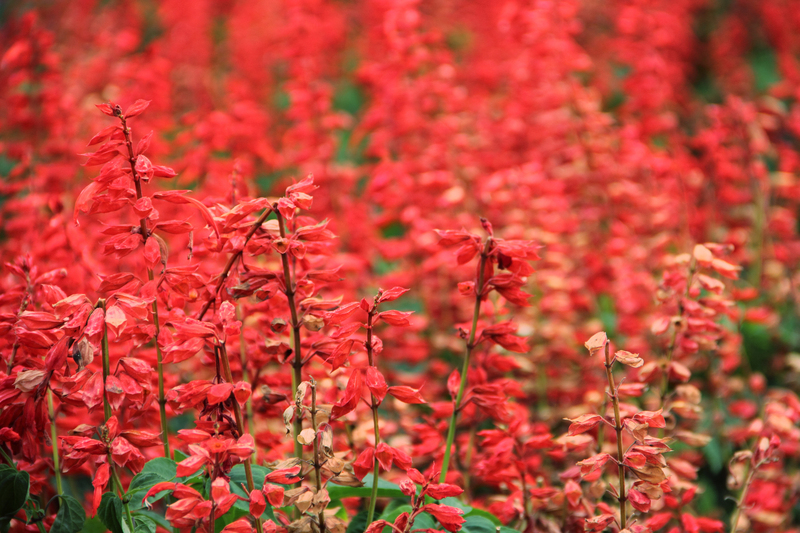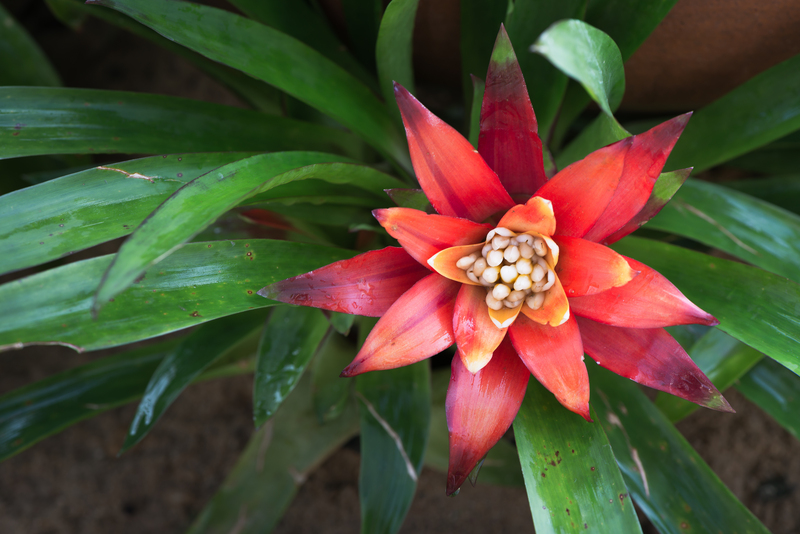From Seeds to Seasonings: Cultivate Your Herb Sanctuary
Posted on 08/06/2025
From Seeds to Seasonings: Cultivate Your Herb Sanctuary
Herbs have been treasured for centuries--not just for their culinary uses, but also for their medicinal and aromatic properties. If you've ever dreamed of effortlessly snipping fresh rosemary or mint straight from your own windowsill, you're in the right place. Cultivating a personal herb garden--your very own herb sanctuary--transforms both your cooking and your connection to the natural world. In this comprehensive article, we guide you from selecting seeds to seasoning your favorite dishes with homegrown flavor.

Why Start an Herb Sanctuary? The Benefits are Boundless
- Fresh Flavors Year-Round: Homegrown herbs deliver unbeatable taste compared to dried store-bought varieties.
- Cost Savings: Growing herbs saves money and provides a continual, plentiful supply.
- Health and Wellness: Many culinary herbs boast health benefits, from antioxidant properties to digestion aids.
- Sustainability: Growing your own herbs minimizes packaging waste and reduces your carbon footprint.
- Therapeutic Hobby: Gardening relieves stress and offers gentle exercise.
Creating your herb sanctuary isn't just about gardening--it's about cultivating a thriving micro-ecosystem that supports your lifestyle, kitchen, and even your mental well-being.
Choosing the Right Herbs for Your Herb Sanctuary
Before you get your hands dirty, consider your goals and environment. Here are several popular and easy-to-grow herbs to plant from seed, perfect for beginners and seasoned gardeners alike:
- Basil: Essential in Italian and Southeast Asian dishes; loves warm climates.
- Mint: Perfect for teas, desserts, and cocktails; grows vigorously.
- Rosemary: Aromatic and hearty, great with roasted vegetables and meats.
- Parsley: Versatile; used as garnish and in soups, salads, and sauces.
- Cilantro: Adds robust flavor to salsas and curries.
- Thyme: Durable and flavorful; complements meats and vegetables.
- Chives: Mild onion flavor, perfect for garnishing a variety of dishes.
- Dill: Ideal for pickling, salads, and yogurt-based sauces.
Tip: Start with 3-5 varieties suited to your climate and kitchen preferences when establishing your herb sanctuary. Gradually add more as you gain confidence and experience.
Seeds vs. Seedlings: What's the Difference?
Growing from seeds gives you the magic of witnessing full life cycles and greater variety options. Starting from seedlings is faster, but purchasing seeds allows for cost savings, control over varieties, and satisfaction from nurturing life from humble beginnings.
Preparing Your Space: Indoors or Outdoors?
Not everyone has access to sprawling garden beds, but that shouldn't deter you. Herbs are exceptionally adaptable and can thrive in various environments. Here's how to pick the ideal spot for your home herb garden:
Outdoor Herb Gardens
- Select a well-drained, sunny area (ideally 6-8 hours of sunlight per day).
- Herbs prefer slightly alkaline, loose soil enriched with compost.
- Consider raised garden beds or traditional rows for easier access and maintenance.
Indoor Herb Gardens
- Choose south- or west-facing windowsills for optimal light.
- Use containers with drainage holes.
- Opt for high-quality potting mix; refresh periodically for healthy growth.
- If natural light is limited, supplement with LED grow lights.
Remember, indoor herb sanctuaries are perfect for apartment dwellers and can even add a touch of greenery to your kitchen with countertop planters or vertical gardens.
How to Start Your Herb Sanctuary: Step-by-Step Guide
1. Selecting and Sourcing Seeds
Look for reputable seed companies specializing in culinary or organic herbs. Heirloom varieties offer superior flavor profiles and historical significance, while organic seeds ensure environmentally friendly cultivation.
2. Sowing Seeds Indoors
- Timing: Most herbs can be started indoors 6-8 weeks before the last spring frost.
- Containers: Use seed trays, recycled yogurt containers, or biodegradable pots.
- Planting: Follow packet instructions--typically, plant seeds at a depth 2-3 times their size.
- Moisture: Keep soil moist but not soggy; water with a misting spray until seedlings emerge.
- Temperature: Maintain temperatures between 65-75?F (18-24?C) for optimal germination.
3. Transplanting Seedlings
- Once seedlings have at least two pairs of true leaves, harden them off by gradually exposing them to outdoor conditions for 7-10 days.
- Transplant into garden beds or larger containers, maintaining optimal plant spacing (refer to seed packet guidelines).
4. Caring for Your Herb Sanctuary
- Watering: Water deeply but less frequently, allowing soil to dry out between sessions.
- Pruning: Regular harvesting and pinching back promote bushier, healthier plants.
- Mulching: Apply a light layer of mulch to retain moisture and suppress weeds outdoors.
- Feeding: Fertilize monthly with a balanced, organic liquid fertilizer.
- Pest Management: Use natural remedies, such as neem oil or insecticidal soap, to combat common issues.
Pro Tip: Avoid using chemical pesticides or herbicides in your herb sanctuary to keep your harvests safe and edible.
Harvesting and Preserving Your Herbs
When and How to Harvest
- Begin harvesting when plants are healthy and at least 6-8 inches tall.
- For leafy herbs (like basil, oregano, mint), pinch or cut stems above a leaf node for rapid regrowth.
- Harvest in the morning--after dew dries but before heat intensifies--for optimal flavor and essential oil retention.
Preserving your Herb Bounty
To enjoy the flavors of your herb sanctuary year-round, try these preservation methods:
- Drying: Hang herbs in small bunches upside down in a dry, well-ventilated area, or use a dehydrator for uniform results.
- Freezing: Chop fresh herbs and freeze in ice cube trays with water or olive oil for instant seasoning boosts.
- Infusing: Create herb vinegars, oils, or butters for gourmet touches to your meals.
From Your Garden to Your Kitchen: Elevate Every Meal
There is nothing more satisfying than transforming your seed-grown herbs into culinary masterpieces. Here's how to integrate your herb sanctuary's bounty into everyday cooking:
- Garnish--Sprinkle chopped chives or parsley over eggs, potatoes, or salads for a fresh finish.
- Infuse--Add thyme or rosemary stems to roasting meats or vegetables for deeper flavor.
- Whip Up Sauces--Blend basil, garlic, and olive oil for vibrant homemade pesto.
- Craft Herb Teas--Steep fresh mint, lemon balm, or chamomile for soothing herbal infusions.
- Homemade Seasonings--Mix dried herbs with sea salt or pepper for custom rubs and blends.
Experiment! The more you use your homegrown herbs, the more you'll expand your culinary creativity.
Common Problems and Solutions in Herb Gardening
Yellow Leaves
Often a sign of overwatering or poor drainage. Let the soil dry between watering, and ensure pots aren't sitting in pooled water.
Leggy Growth
This occurs when herbs don't receive enough sunlight. Move them to a brighter spot, or consider supplemental lighting indoors.
Pests
- Aphids, spider mites, or whiteflies--Spray with a gentle, homemade soap solution.
- Snails and slugs--Hand-pick at dusk or use natural barriers like crushed eggshells around pots.
Designing a Beautiful Herb Sanctuary
Your herb haven should be as pleasing to the eye as it is to the palate! Here are some creative ways to make your space an inviting retreat:
- Use decorative pots: Match your personal style with ceramic, clay, or recycled containers.
- Vertical gardens: Install wall-mounted planters inside or outside to save space and create living art.
- Mix textures and colors: Pair silver-leaved sage with bright green basil and trailing thyme.
- Incorporate companion plants: Add marigolds or nasturtiums to deter pests and enhance visual appeal.
- Create meditation nooks: Surround a small bench with fragrant lavender or rosemary for relaxation.

Eco-Friendly and Organic Practices in Your Herb Sanctuary
Transforming your herb garden into an eco-conscious sanctuary amplifies its benefits. Here's how:
- Compost kitchen scraps to enrich your soil naturally.
- Collect rainwater for irrigating your plants--eco-friendly and cost-saving.
- Choose organic seeds and fertilizers for a sustainable, chemical-free garden.
- Encourage pollinators by planting flowering herbs like dill and fennel.
- Practice crop rotation to keep soil healthy and minimize pest problems.
Every step towards sustainability turns your herb sanctuary into a model for responsible, flavorful living.
Conclusion: Start Your Seed-to-Seasoning Journey Today!
Embarking on the journey from seeds to seasonings is more than growing herbs--it's a lifestyle. Your herb sanctuary will supply the freshest ingredients, inspire hands-on creativity in the kitchen, and offer an endless source of wellness and relaxation. Whether you're cultivating a sunny windowsill box or a sprawling backyard plot, the rewards are both practical and profound.
With a little time, patience, and the helpful guidance provided here, you can nurture nature's most versatile plants--and enjoy the pleasure of seasoning every dish with your own hands. Transform your home into a herb sanctuary and savor the delightful journey from seed to seasoning!



